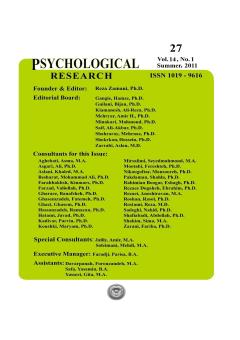رابطۀ بین جوّ روانی با توانمندسازی روانی در كاركنان کارخانه های صنعتی
الموضوعات : psychologyمحمدرضا غفوری ورنوسفادرانی 1 , عبدالزهرا نعامی 2 , نسرین ارشدی 3
1 - دانشگاه پیامنور زرینشهر، ایران
2 - دانشگاه شهید چمران اهواز، اهواز، ایران
3 - دانشگاه شهید چمران اهواز، اهواز، ایران
الکلمات المفتاحية: جوّ روانی, توانمندسازی روانی,
ملخص المقالة :
چكيده: این پژوهش با هدف بررسی رابطۀ بین جوّ روانی با توانمندسازی روانی انجام شد. به این منظور، از کل کارکنان شش کارخانۀ صنعتی، تعداد 350 نفر با استفاده از روش نمونهگیری تصادفی ساده انتخاب شدند. ابزارهای پژوهش پرسشنامۀ جو روانی و پرسشنامۀ توانمندسازی روانی بودند. شواهد مربوط به روایی پرسشنامهها با استفاده از تحلیل عاملی تأییدی مورد بررسی قرار گرفت که در حد قابل قبولی بود. شواهد بهدست آمده حاکی از آن است که بین مؤلفههای جوّ روانی (استقلال، انسجام، اعتماد، فشار، حمایت، قدردانی، انصاف، و نوآوری) با توانمندسازی روانی و ابعاد آن روابط معنادار (01/0>P) وجود دارد. نتایج رگرسیون گام به گام نشان داد که مؤلفههای استقلال، انسجام، و نوآوری مهمترین مؤلفههای پیشبینیکنندۀ توانمندسازی روانی و ابعاد آن هستند.
Ashforth, B. E. (1989). The experience of powerlessness in organizations. Organizational Behavior and Human Decision Processes, 43, 207-242.
Bandura, A. (1989). Human agency in social cognitive theory. American Psychologist, 44, 1175-1184.
Bell, N. E., & Staw, B. M. (1989). People as sculptors versus sculpture. In M. B. Arthur, D. T. Hall, & B. S. Lawrence (Eds.), Handbook of career theory, (PP.232-251). NewYork: Cambridge University Press.
Brief, A. P., & Nord, W. R. (1990). Meanings of occupational work. Lexington, M.A: Lexington Books.
Carless, S. A. (2004). Does psychological empowerment mediate the relationship between Psychological climate and job satisfaction? Journal of Business and Psychology, 18, 405-425.
Cohen, H., Maninon, L. M., & Morrison. J. (2002). Research and sampling. New York: Jossy-Bass.
Conger, J. A., & Kanungo, R. N. (1988). The empowerment process: Integrating theory and practice. Academy of Management Review, 13, 471-482.
Deci, E.L., Connell, J.P., & Ryan, R.M. (1989). Self-determination in a work organization. Journal of Applied Psychology, 74, 580-590.
DeCremer, D., & Blader, S. (2006). Why do people care about procedural fairness? The importance of belongingness in responding and attending to procedures. European Journal of Social Psychology,36, 211-228.
Ergeneli, A., Ari, G. S., & Metin, S. (2007). Psychological empowerment and its relationship to trust in immediate managers. Journal of Business Research, 60, 41-49.
Gist, M. (1987). Self-efficacy: Implications for organizational behavior and human resource management. Academy of Management Review, 12, 472-485.
Gist, M., & Mitchell, T. N. (1992). Self-efficacy: A theoritical analysis of its determinants and malleability. Academy of Management Review, 17, 183-211.
Hackman, J. R., & Oldham, G. R. (1980). Work redesign. Reading, MA: Addison-Wesley.
James, L. A., & James, L. R. (1989). Integrating work environment perceptions: Explorations in the measurement of meaning. Journal of Applied Psychology, 79, 739-751.
James, L. R., James, L. A., & Ashe, D. K. (1990). The meaning of organization: The role of cognition and values. Organizational climate and culture (PP.40-84). San Francisco: Jossey-Bass.
Koys, D. J., & Decotiis, T. A. (1991). Inductive measures of psychological climate. Human Relations, 44, 265-285.
Larsson, S., Pousette, A., & Torner, M. (2007). Psychological climate and safety in the construction industry-mediated influence on safety behavior. Safety Science, Article in press.
Lawler, E. E. (1992). The ultimate advantage. San Francisco: Jossey-Bass.
Martin, C.A. (2001). Customer-oriented selling: An empirical examination of organizational and individual antecedents, and performance outcomes. Unpublished doctoral dissertation. The University of Memphis.
Martin, C. A., & Bush. A. J. (2006). Psychological climate, empowerment, leadership style, and customer-oriented selling: An analysis of the sales manager-salesperson dyad. Journal of Academy of Marketing Science, 34, 419-438.
Martinko, M. J., & Gardner, W. L. (1982). Learned helplessness: An alternative explanation for performance deficits. Academy of Management Review, 7, 195-204.
Muller, B.H., & Lee, J. (2002). Leader-member exchange and organizational communication satisfaction in multiple contexts. Journal of Business Communication, 39, 220-244.
Pinder, C. G. (1998). Work motivation in organization behavior. Prentice-Hall, Upper Saddle River, NJ.
Quinn, R. E., & Spretzer, G. M. (1997). The road to empowerment: Seven questions every leader should consider. Organizational Dynamics, Autumn, 37-49.
Rego, A., & Cunha, M.P.E. (2007). Perceptions of authentizotic climates and employee happiness: Pathways to individual performance?. Journal of Business Research, Article in press.
Reichers, A. E., & Schneider, B. (1990). Climate and culture: An evolution of constructs. In B. Schneider (Ed.), Organization Climate and Culture (pp.5-39). San Francisco: Jossey-Bass.
Schneider, B., Bowen, D. E., Ehrhart, M. G., & Holcombe, K. M. (2000). The climate for service: Evolution of a construct. In N.M. Ashkanasy, C. P. M. Wilderom, & M. F. Peterson (Eds), Handbook of Organizational Culture & Climate (PP.21-36). Thousand oaks, CA: Sage.
Spreitzer, G. M. (1995). Psychological empowerment in the workplace:
Dimensions, measurement, and validation. Academy of Management Journal, 38, 1442-1465.
Spreitzer, G. M. (1996). Social structural characteristics of psychological empowerment. Academy of Management Journal, 39, 483-504.
Stewart, G. L., & Manz, C. C. (1997). Understanding and overcoming supervisor resistance during the transition to employee empowerment. Research in Organizational change and Development, 10, 169-196.
Swift, C. O., Campbell, C. (1998). Psychological climate: Relevance for sales managers and impact on consequent job satisfaction. Journal of Marketing Theory and Practice, 6, 27-37.
Thomas, K. W., & Velthouse, B. A. (1990). Cognitive elements of empowerment. Academy of Management Review, 15, 666-681.
Wolf, L. M., & Robertshaw, D. (1982). Effects of college attendance on locus of control. Journal of Personality and Social Psychology, 43, 802-810.


